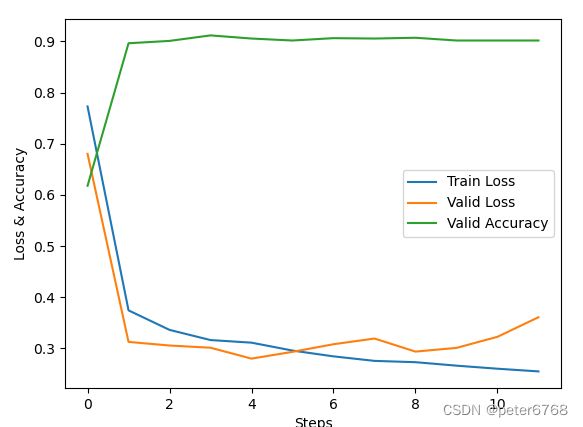pytorch集智4-情绪分类器
1 目标
从中文文本中识别出句子里的情绪。和上一章节单车预测回归问题相比,这个问题是分类问题,不是回归问题
2 神经网络分类器
2.1 如何用神经网络分类
第二章节用torch.nn.Sequantial做的回归预测器,输出神经元只有一个。分类器和其区别如下
1 分类器输出单元有几个,就有几个分类
2 分类器各输出单元输出值加和为1(值表示某个预测分类的概率,概率求和为1)
3 回归预测最后一层可以用sigmoid,分类不行,因为sigmoid无法保证分类器输出单元值求和为1,可以用softmax,表达式如下
2.2 分类问题损失函数
分类问题损失函数一般用交叉熵:
N表示样本数量,Ci表示第i个样本的类别标签,y表示每个样本的损失值
3 词袋模型分类器
直白理解:就是统计句子里各词语出现数量,忽略语法,语义等因素
思想:1 将句子转化为词袋,然后可以onehot处理,方便用神经网络预测;2 大概思想:在词袋里寻找和输出相关关键词语,然后统计词语数量,哪个输出类别的敏感词语统计数量高,结果就是哪个输出类别
数据预处理:可以归一化处理,网络计算会更快
3.1 简单文本分类器
背景与数据:获取网购商城顾客评论信息,从评论信息获取句子情绪
神经网络组成:用前馈神经网络,有3层,分别是输入,中间,输出层,输出层数量有两个,分别代表情绪是正面还是负面
3.2 程序实现
3.2.1 数据处理
主要步骤:处理标点,句子分词,建立词表
标点处理:正则,涉及的标点全部删除
句子分词:使用jieba模块对句子分词
建立词表:python字典建立词表
def deal_punc(sentence):
sentence = re.sub('[\s+\.\!\/_,$%^*(+\"\'“”《》?]+|[+——!,。?、~@#¥%……&*():)]+', '', sentence)
return sentence
def prepare_data(good_file, bad_file, is_filter=True):
print('prepare data begin')
all_words = []
pos_sen, neg_sen = [], []
for path, sen in zip((good_file, bad_file), (pos_sen, neg_sen)):
with open(path, 'r', encoding='utf-8') as f:
for index, line in enumerate(f):
if is_filter:
line = deal_punc(line)
words = jieba.lcut(line)
if len(words) > 0:
all_words += words
sen.append(words)
print(f'{path} include {index} rows, all words:{len(all_words)}')
print(f'pos_sen len:{len(pos_sen)}, neg_sen len:{len(neg_sen)}')
diction = {}
cnt = Counter(all_words)
for word, freq in cnt.items():
diction[word] = [len(diction), freq]
print(f'diction len:{len(diction)}')
return (pos_sen, neg_sen, diction)
def word2index(word, diction):
if word in diction:
value = diction[word][0]
else:
value = -1
return (value)
def index2word(index, diction):
for w, v in diction.items():
if v[0] == index:
return (w)
return (None)
3.2.2 文本数据向量化
pos_sen, neg_sen, diction = prepare_data_sample(good_file, bad_file)
st = sorted([(v[1], w) for w, v in diction.items()])
datasets, labels, sentences = [], [], []
'''
for sens, tag in zip((pos_sen, neg_sen), (0, 1)):
for sen in sens:
new_sen = []
for l in sen:
if l in diction:
new_sen.append(word2index_sample(1, diction))
datasets.append(sentence2vec_sample(new_sen, diction))
labels.append(tag)
sentences.append(sen)
'''
for sentence in pos_sen:
new_sentence = []
for l in sentence:
if l in diction:
new_sentence.append(word2index(l, diction))
datasets.append(sentence2vec_sample(new_sentence, diction))
labels.append(0) #正标签为0
sentences.append(sentence)
# 处理负向评论
for sentence in neg_sen:
new_sentence = []
for l in sentence:
if l in diction:
new_sentence.append(word2index(l, diction))
datasets.append(sentence2vec_sample(new_sentence, diction))
labels.append(1) #负标签为1
sentences.append(sentence)
indices = np.random.permutation(len(datasets))
datasets = [datasets[i] for i in indices]
labels = [labels[i] for i in indices]
sentences = [sentences[i] for i in indices]3.3.3 划分数据集
训练集,校验集,测试集,比例一般为10:1:1
# split train, test, verify datasets
test_size = int(len(datasets) // 10)
train_data = datasets[2 * test_size :]
train_label = labels[2 * test_size : ]
valid_data = datasets[: test_size]
valid_label = labels[: test_size]
test_data = datasets[test_size : 2 * test_size]
test_label = labels[test_size : 2 * test_size]3.3.4 建立神经网络
结构:输入层(约7000个样本),一个中间层(10个隐单元),输出层(2个单元)
注意,此处用的是relu,不是sigmoid。原因:虽然x>0时没处理数据,但x<0时为0让relu有了非线性的能力,且运算比sigmoid简单,速度更快,方便反向误差传导
def plot(records):
print('plot begin')
a = [i[0] for i in records]
b = [i[1] for i in records]
c = [i[2] for i in records]
pyplot.plot(a, label='train loss')
pyplot.plot(b, label='verify loss')
pyplot.plot(c, label='valid accuracy')
pyplot.xlabel('step')
pyplot.ylabel('losses & accuracy')
pyplot.legend()
pyplot.show()
def main():
model = torch.nn.Sequential(
torch.nn.Linear(len(diction), 10),
torch.nn.ReLU(),
torch.nn.Linear(10, 2),
torch.nn.LogSoftmax(dim=1),
)
cost = torch.nn.NLLLoss()
optimizer = torch.optim.SGD(model.parameters(), lr=0.01)
records = []
losses = []
for epoch in range(3):
for i, data in enumerate(zip(train_data, train_label)):
x, y = data
x = torch.tensor(x, requires_grad=True, dtype=torch.float).view(1, -1)
y = torch.tensor(np.array([y]), dtype=torch.long)
optimizer.zero_grad()
predict = model(x)
loss = cost(predict, y)
losses.append(loss.data.numpy())
loss.backward()
optimizer.step()
val_losses = []
rights = []
for j, val in enumerate(zip(valid_data, valid_label)):
x, y = val
x = torch.tensor(x, requires_grad=True, dtype=torch.float).view(1, -1)
y = torch.tensor(np.array([y]), dtype = torch.long)
predict = model(x)
right = rightness_sample(predict, y)
rights.append(right)
loss = cost(predict, y)
val_losses.append(loss.data.numpy())
right_ratio = 1.0 * np.sum([i[0] for i in rights]) / np.sum([i[1] for i in rights])
print(f'No.{epoch}, train loss:{np.mean(losses):.4f}, verify loss:{np.mean(val_losses):.4f}, verify accuracy:{right_ratio}')
records.append([np.mean(losses), np.mean(val_losses), right_ratio])
# plot
plot(records)3.3 运行结果
3.4 测试
用模型对测试集验证精度
4 剖析神经网络
下列命令可查看网络结构,返回的是计算图的各节点
print(model.named_parameters())主要分类错误原因如下,解决方案是rnn



